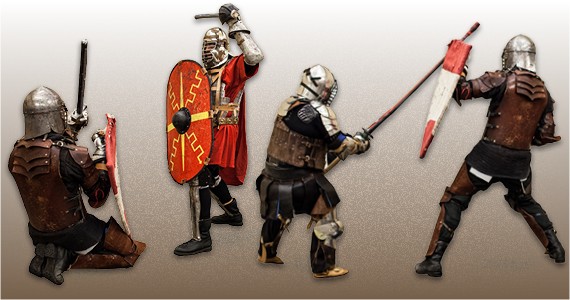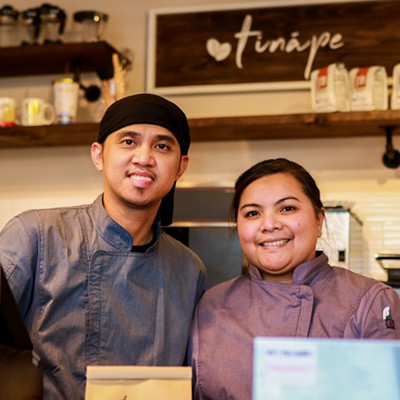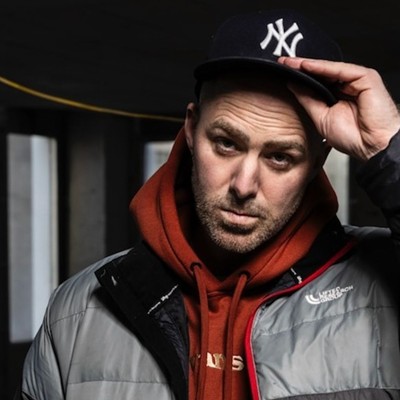The Viking buckles under the weight of his armour, stunted by a fast blow to the thigh; his opponent, the Roman, also drops to his knees. The fight is now fair. Shields crash together, swords slice the air and lords in waiting cheer the victor: the nobility of the Barony of Ruantallan battle one-on-one for the highest honours. It takes skill, stamina and strength to be the last medieval fighter left standing. And it also takes a great leap back in time.
For the last 25 years, the Barony of Ruantallan has represented Nova Scotia and PEI in The East Kingdom, the region north, south and east of Quebec in the worldwide Society for Creative Anachronism. With membership in the hundreds of thousands, the SCA actively recreates nearly every aspect of medieval and renaissance culture. The focal point is the expertly trained, heavily armoured tournament combat.
Every Monday night, the Barony of Ruantallan gathers at the Piers Military Community Centre in Windsor Park at CFB Halifax. (The Barony is largely populated by the members and families of the navy. A hobby that is as much a sport as it is a full-fledged culture, the heavy-armour component appeals to the champion in all of us.
"It's full-force, full-contact, non-choreographed combat," says Stephane Colin, also known as romanesque fighter Spirius. "And it's the best workout I've ever done in my life. It's an aerobic exercise." Between his crested shield, body armour and custom-made helmet, Colin's resting weight on the field is about 53 pounds. "But we're here to kill our friends, not hurt them. We want to get killed and keep fighting," he says. Using solid rattan swords, the armour is important for safety. A helmet and groin cup are required for battle.
With the society's focus on anachronism, or the blending of history, the members of the SCA draw on the different decades, eras and geographies of the Medieval period (1600s and earlier), allowing exploration of many interests.
"I'm going for an earlier Celt," says Nick Hue, an SCA member for 14 years. "I fight the Roman even though I'm about two generations after the Romans pulled out of Britannia. So I have a bit more armour, a bit more metal, scraps I've found in battle." In tartan and Breton-inspired decoration, Hue is welder by trade, using his metalwork skills to make his own gear.
"That way it fits better and it's the look I want," he says, "My armour is mostly leather on the outside and plastic underneath. I've put in a lot of effort to hide the modern materials." He says that the SCA likes to go by the Ten Foot Rule: "If you can look authentic from 10 feet away, awesome, that's what we strive for. But if you can be authentic-looking close-up? Even better," says Hue. A glance at the players shows a range of creativity: each fighter has an individual coat of arms, personal touches and uses their weapons of choice.
"We fight with a sword and shield, two swords, daggers, axes, spears, pole-arms, hammers, maces, any combination we like," says Colin.
In tournament, opponents are randomly matched and spar until one fighter falls. Limbs are dismembered as a player continues to fight. When a hit is received hard enough, it's up to the recipient to call the hit as a fatal death-blow.
"It's an honour system," Colin explains. "I have to decide if the hit was hard enough to have killed me, because if you don't take the shot, they'll hit you harder next time. I either die dramatically or yell for the next player."
The honour system seems to be the group's philosophy. "It's honourable to yourself and to your opponent to accept a hit," says Hue. "And that idea of honour transfers through everything we do in the society."
Off the battlefield, there is a courtly hierarchy that governs the conduct and operations of the Barony. "When you start, you're called m'lord or m'lady," Hue explains. In battle, fighters follow the tradition of courtly love and choose an inspiration for whom to fight. Players give their inspiration a rose before battle. "You're considered an aristocrat, a lord or lady of the land, until you earn your first AOA, the Award of Arms."
The AOA is the earliest award one can receive, which elevates a player's status to higher nobility. Then, there is honourable lordship, Excellency, baron and baroness, prince and princess and king and queen, all honourifics that determine codes of conduct and speech. The award system is exterior framework of the society's organization.
"As easy as it is to showcase the martial activities and fighting, there is so much more to the SCA," says Colin.
Renaissance fencer Maria Psaila explains that although the number of women who fight is disproportionate to the men, "It does happen, for sure. But the SCA also has anything you might be interested in: food, writing, dancing, singing, poetry, sewing, calligraphy, archery."
With hand-sewn coat of arms hung about, hand-made scrolls and awards, period-appropriate food and drink and other Dark Age accoutrements, there's a real ambience. "There's an atmosphere we're trying to create," says Hue. "All of the crafts and arts and sciences and fighting is so wonderful because you're completely immersed."
Masters of re-enactment, most of the citizens of Ruantallan are history buffs; some are professional historians and museum staff. Others are engineers and craftspeople.
All of the fighters flood the ring for a final death match and there can be only one winner. The MC, Baron William Lancton (Pierre Longtin), explains that fighters can team up in group combat but allegiances can be broken. As bodies drop from brutal blows, two players remain, circling each other and gauging their opponent's weakness.
Winning requires concentration and finesse. A shielded block can be a fatal error. A stumble can mean the end. A full-court, full-battle victory tastes much sweeter. "Really, we're all about trying to help each other out," says Hue. "It's about trying to grow as a person and be a better person, too."
Resuming battle training on November 25, there is no cost to try out the combat. From 6 to 9pm on Mondays, fighters practice skills and agility as fencers practice aim, while the arts and sciences contingent works on projects like hand-scripted awards and period clothing, as the Baron and Baroness oversee titular duties like finances and admin.
"It costs nothing to come and try it out," says Longtin. "All you need is a groin protection cup. We have helmets, armour and sticks to lend, and once you get into it, you want to design and learn how to make your own armour."
Once a peer member of the Barony, the SCA provides opportunities to travel all over the world for tournaments and events. For those members in the Navy, almost every Canadian post has an SCA contingent, so players can pick right up in a new city. But the eastern Barony of Ruantallan, under a cobalt and white coat of arms, is an incredibly active group of medieval enthusiasts who are as welcoming as they are fierce and noble.















